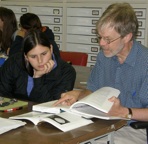A National Science Foundation Research Experiences for Undergraduates Site
Department of Anthropology, University of Notre Dame, Notre Dame, IN 46556

Guest Scientist
Prof. Clark Spencer Larsen of the Ohio State University Department of Anthropology was the guest scientist for the 2008 Program. He worked with each group to fine tune their research design studying daily activity patterns.

Kevin Hatala [Duke University] & Stephanie Hubert [University of Arizona]
This study investigates the structural characteristics of femora of the Early Bronze Age (EBA) peoples of Bab edh-Dhra, Jordan through the use of cross-sectional geometric analysis. The sample (n=42) was comprised of adult femora excavated from charnel house A22, which was used as a bone repository during the EBA II-III (2950-2300 B.C.). Subtrochanteric cross-sectional geometric properties were calculated and compared to those of other groups on which similar studies had been conducted. The results indicated that mechanical stresses on the subtrochanteric region of the femora of the Bab edh-Dhra’ people were likely intermediate in severity, with no evidence of significant trends in increased or decreased mobility relative to other groups.
However, several factors in cross-sectional analysis of the femoral subtrochanteric region presented difficulties and limitations, especially related to the commingled and fragmentary nature of the Bab edh-Dhra’ sample. While the findings of this study are consistent with archaeological evidence of possible increased sedentism at Bab edh-Dhra’ during the EBA II-III, further work with this sample would benefit from additional comparative data samples upon which inferences regarding activity patterns could be based.
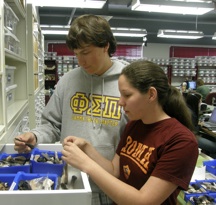
Osteoarthritis of the Talar Articular Surface of the Distal Fibulae from Bab edh-Dhra’ Charnel House A22
Katie Ausburn [Henderson State University] & William Hawkins [Louisiana State University]
Osteoarthritis was scored for the talar articular surface of the distal fibulae from charnel house A22 at the archaeological site of Bab edh-Dhra’. Over two hundred distal fibulae were scored based on an ordinal scale of severity; severity of osteoarthritis was extremely light within the sample. There were no significant differences between right and left fibulae, but there were significant differences between hunter-gatherer populations from other studies and Bab edh-Dhra’. Minimal osteoarthritis of the fibula suggests that life at Bab edh-Dhra’ was significantly less stressful for individuals of charnel house A22 than from comparable hunter-gatherer groups. The authors conclude that the talar articular surface is an inadvisable area to study osteoarthritis, due to certain biomechanics and lack of data within the field.
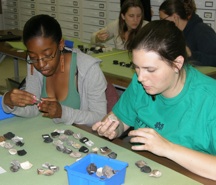
Osteoarthritis of the Patella: A Biocultural Investigation of the A22 Charnel House, Bab edh-Dhra’, Jordan
Celia Brunson [SUNY-Binghampton] & Ellen Loforo [Vanderbilt Universityh]
Bioarchaeology is the study of human remains from archeological contexts. It attempts to reconstruct daily lifeways and overall health of past populations from their skeletal remains. More specifically, these remains can be used to infer diet and activity patterns. An approach that considers both the skeletal remains and the historical aspects of a site can reveal much about past peoples. The goal of this research project was to study patellae for evidence of osteoarthritis and implications of daily activities in an Early Bronze Age II-III (2900-2300 B.C.) skeletal collection excavated from the A22 charnel house at the site of Bab edh-Dhra’, Jordan.
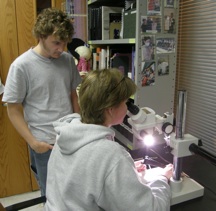
Degenerative Joint Disease in the Distal Tibia: A Study of the Activity Patterns of Bab edh-Dhra’
Sarah Stanley [Colorado College] & Ryan Rindler [Ball State University]
Osteoarthritis was scored for the talar articular surface of the distal fibulae from charnel house A22 at the archaeological site of Bab edh-Dhra’. Over two hundred distal fibulae were scored based on an ordinal scale of severity; severity of osteoarthritis was extremely light within the sample. There were no significant differences between right and left fibulae, but there were significant differences between hunter-gatherer populations from other studies and Bab edh-Dhra’. Minimal osteoarthritis of the fibula suggests that life at Bab edh-Dhra’ was significantly less stressful for individuals of charnel house A22 than from comparable hunter-gatherer groups. The authors conclude that the talar articular surface is an inadvisable area to study osteoarthritis, due to certain biomechanics and lack of data within the field.
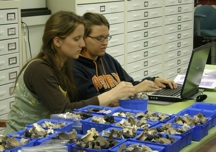
Natalie Glynn [Auburn University] & Amber Weekes [University of Pennsylvania]
This project utilizes a biocultural approach in the examination of 558 lumbar vertebrae from Charnel House A-22, Bab edh-Dhra’, Jordan. This research uses a unique 8 quadrant system for the examination of osteophytic activity on the vertebral margin. Significant differences were not found when the frequencies of osteoarthritis in the anterior vs posterior, superior vs inferior, and right vs left surfaces were compared. However, statistically significant differences are present when the frequency of osteoarthritis in the anterior-superior quadrants C and D is compared to that observed in quadrant A. Additionally, statistically significant differences exist when the frequency of osteoarthritis in this collection’s first lumbar vertebrae is compared to that of various hunter-gatherer, mixed-economy, and agricultural groups. Further research is needed to better understand the activity patterns that may have resulted in the moderate osteoarthritis that was observed in this community.
\


Previous NSF-REU Summers
A summary of previous research projects can be found:


